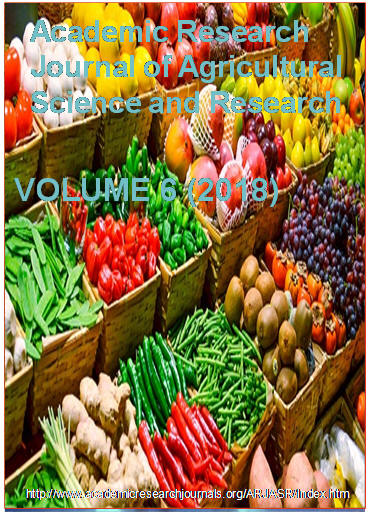| ARJASR |
Academic Research Journal of
Agricultural Science and Research |
||||||||||||||||||||||
|
Academic Research Journal of Agricultural Science and Research Vol. 6(2), pp. 116-124. February, 2018. ISSN: 2360-7874 DOI: 10.14662/ARJASRD2017.092 Full Length Research Assessment of Major Livestock Feed Resources and Feeding Systems in Bench-Maji Zone; South Western Part of Ethiopia
Tesfaye Feyisa Aduna 1* and Melese Dejen2
1*Wolkite University, College of Agriculture and Natural Resource, Department of Animal Production and Technology, P.O.Box 07, Wolkite, Ethiopia. 2Debra-Tabor University, College of Agriculture, Department of Animal Sciences, P.O.Box 5, Tabor, Ethiopia
*Email: tesfaye.feyisa@gmail.com
Accepted 16 January 2018
The study was conducted with the objectives of assessing major livestock feed resources and its utilization practices in Bench-Maji Zone, South Nations, Nationalities, Peoples Region (S.N.N.P.R). The average farm size owned per household (hh) in Surma (3.03 ha) were significantly higher (P<0.001) than the average farm size owned by Shey-Bench (2.48ha) and Semen Bench (1.95ha). Out of the total land owned per household; about 0.56, 0.18 and 0.29, and 0.00, 0.21 and 0.07 hectares were allocated for grazing and forage, respectively in Surma, Shey-bench and Semen Bench. Cattle, sheep, goats, poultry and equines were reared by the local community of the three woredas. The number of cattle and goats reared per hh in Surma Woreda was significantly higher (P<0.05) than that of Shey-bench and Semen Bench. Similarly, there was significantly large number of chickens in Surma woreda than Shey-bench. But, there were no significance difference for chickenís production in Surma and Semen Bench woredas. Contrast to chickens; there were significantly higher sheep and equine production in Shey- Bench than Semen Bench and Surma woredas. Moreover, there was no Equine production in Surma woreda might be due to the feeding habit of Equines in addition to prevalence of disease. The most limiting constraint to livestock was shortage of grazing land and healthy problems. Shortage of grazing land might have been caused by the high human population density that demanded more land for crop production leading to a reduction in grazing areas with the resultant overstocking of communal grazing lands. With this regard, natural pasture was the primary source of feed to animals in all selected woredas in which 100% of sampled respondents in the Semen Bench and Surma woreda, and 90% in the Shey-Bench Woreda ranked as the primary source of feed to their animals. In general, the major feed resources to livestock in the study area were natural pasture, crop residues, cultivated pasture, hay, left over of banana and/enset and taro leaf.
Keywords: livestock, feed resource, feeding system, Bench-Maji Zone
How to cite this article: Aduna TF, Dejen M (2018). Assessment of Major Livestock Feed Resources and Feeding Systems in Bench-Maji Zone; South Western Part of Ethiopia. Acad. Res. J. Agri. Sci. Res. 6(2): 116-124
|
|
|||||||||||||||||||||
